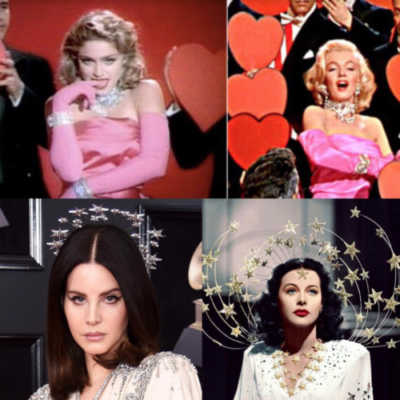The comparison of Lana Del Rey to Madonna isn’t necessarily a likely one–especially considering Del Rey’s largely tween/Tumblr fandom has little respect for any god Del Rey doesn’t unwittingly sanction in her oeuvre. But at last night’s sixtieth annual Grammy Awards, LDR showed herself to be a savvy practitioner of the very thing that has kept Madonna in the spotlight for this long: artful imitation. Draped in Gucci and a star crown that some likened to being an homage to the Statue of Liberty (though Del Rey, traitor to her coast that she is, insisted, “It’s both Hollywood and New York.”), it was, in fact, Old Hollywood screen gem Hedy Lamarr that Del Rey was reinventing for her own aesthetic.
This, too, is precisely what Madonna has done from the outset of her career, getting particularly grandiose with her replications for the “Material Girl” video in 1985, wherein director Mary Lambert re-created the set for Gentlemen Prefer Blondes and Madonna, in turn, re-created Marilyn Monroe as Lorelei Lee. Of course, Madonna would continue to do this type of thing throughout her career, “lightly borrowing” from such filmmakers as Fritz Lang for “Express Yourself” and such photographers as Horst P. Horst for “Vogue.” Like Madonna, Del Rey has gotten a bit subtler in her, shall we delicately call them, counterfeitings (though Radiohead might vehemently disagree).
Sure, she might still directly rip off lyrics from icons of the 60s, but she now has the sense of irony to more appropriately credit them (e.g. singing the according bar from “Scarborough Fair” that the song “Cherry” cops from on her current world tour, LA to the Moon). And it’s true what they say (“they” being most people who have become famous and successful in the arts): imitation is the sincerest form of flattery. In Madonna and Lana Del Rey’s case, this is true. It is emulation, pulling from all of their sponge-like intellectual studies (Madonna has read more books and seen more movies than most literature and film grad students would ever have the ambition to and Lana Del Rey has a fucking philosophy degree from Fordham) that have only enhanced the work of these two women over time.
However, like some perpetual cycle of parodied mimicry, the fans, in turn feel inclined to adopt the look of their respective idols (it was Madonna that spawned the very term “wannabe”) in these various incarnations that have already been done by fore-icons. Which is where the full quote from Oscar Wilde comes into play: “Imitation is the sincerest form of flattery that mediocrity can play to greatness.”
And, to be sure, there is a lot of mediocrity amid what is known as a “fanbase.” The sort of ilk who have nothing to channel their passions into other than idolatry and blind worship. And that’s precisely what someone with a discerning ability to “pay tribute” to the past can capitalize on in making old material new again in her own repackaged way. Of course, as both singers can attest to, not everyone feels imitation is flattering so much as outright theft of intellectual property. Just look at Madonna’s fair share of lawsuits over the decades thanks to her far-reaching artistic tastes. At the same time, all a truly talented person can do these days is take from the best of what’s already been done before. Paired with a persona that’s marketable, it’s only natural that such an artist should remain fascinating long enough to remain famous in a world with an increasingly short attention span. Which means an absorber of pop culture has little patience for taking note of anybody less than someone both aesthetically and sonically imitable. Luckily, Madonna remains so even to Del Rey, who will soon be recording her own rendition of, fittingly, “You Must Love Me.”





















